Varutharacha Chicken Curry (Kerala Chicken Curry with Roasted Coconut) is a thick curry made with roasted coconut. It’s popular across Kerala and especially loved in the Malabar region.
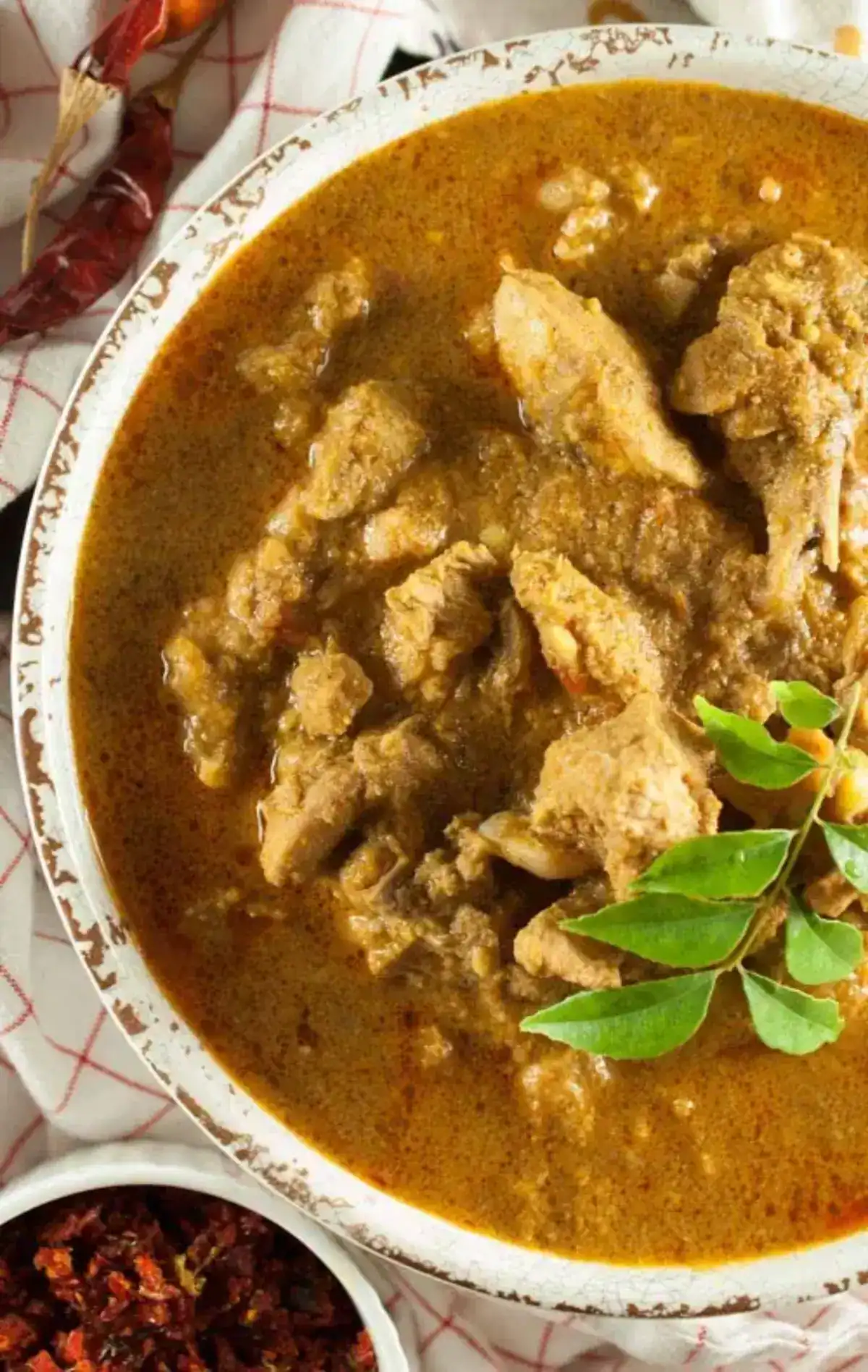
Varutharacha means roasted and ground. Coconut, shallots, and spices are dry-roasted and ground into a smooth paste. This gives the curry a warm brown color and nutty, earthy taste. It’s not like coconut milk-based curries. This one is richer and more intense.
You can make it at home with simple steps. Scroll down for ingredients, cooking method, serving ideas, and storage tips.
Jump to:
- What is Varutharacha Chicken Curry?
- Why You'll Love This Recipe?
- Recipe Ingredients
- Variations to Try
- How To Make Varutharacha Chicken Curry (Step-by-Step Guide)
- Tips And Tricks
- Serving Suggestions
- Storage Instructions
- Frequently Asked Questions (FAQ)
- More Kerala Chicken Recipes To Try
- Kerala Chicken Curry with Roasted Coconut (Varutharacha Chicken Curry)
What is Varutharacha Chicken Curry?
Varutharacha Chicken Curry is a Kerala-style chicken curry made with roasted coconut paste. Coconut and spices are dry-roasted, then ground to a smooth mix. This paste is added to the base masala along with the chicken.
The most important step in this recipe is roasting and grinding the coconut. It takes time, but gives the curry its real taste. If you rush this step, the coconut can turn bitter.
In many Kerala homes, this paste is made in bulk. Grated coconut is slow-roasted with a little coconut oil. No water is added while roasting or grinding. Everything must stay dry. The grinder, jars, and spoons should be clean and moisture-free.
After grinding, store the paste in airtight glass jars. A layer of coconut oil forms on top within two days. Do not remove it. That oil protects the paste and keeps it safe for long-term use.
You can use this paste for any varutharacha curry. Whether it is beef, mutton, seafood, or even vegetable curry, the method stays the same. Take the paste and add it to the curry base along with the rest of the spices and ingredients.
If you want to see how this base works in seafood, try our Varutharacha Prawns Curry next.
Why You'll Love This Recipe?
Even a small serving of this curry goes a long way. It pairs perfectly with rice or pathiri and doesn’t need any extra sides. That’s how flavourful it is. The colour is warm, the texture is thick, and the smell of roasted coconut fills the whole plate.
This is a dish made for festive days and family gatherings. If you have homemade varutharacha paste ready, this becomes one of the easiest chicken curries to make.
Recipe Ingredients
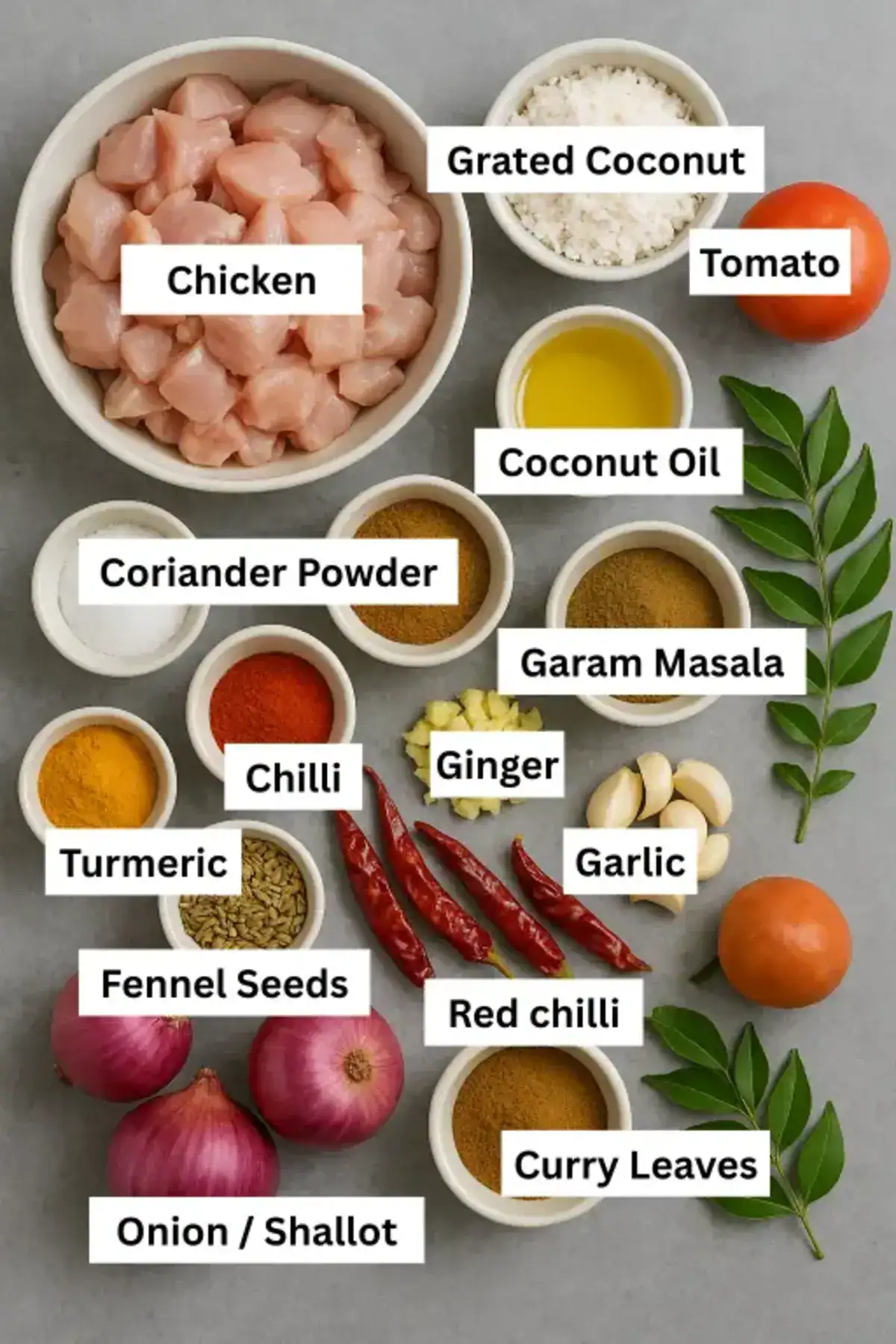
1. Chicken
Use curry-cut pieces with bone. It gives more flavour to the curry. Fresh, farm-raised chicken is best. Frozen chicken is fine if needed. Try to avoid broiler chicken.
2. Grated Coconut
Use only fresh grated coconut. It gives the real taste, smell, and oil. No other substitute works in this recipe.
If you're looking for a coconut-free option, try our most-viewed Nadan Kozhi Curry (No Coconut) recipe.
3. Other Ingredients
Shallots, onion, garlic, ginger, tomato, dry red chilli, fennel seeds, turmeric powder, coriander powder, chilli powder, garam masala, curry leaves, salt, and lemon juice.
Exact quantities and nutrition details are given in the recipe card below.
Variations to Try
The varutharacha technique has small variations depending on what you roast with the coconut. The most basic method uses only grated coconut and a little coconut oil. Roast the coconut slowly until golden brown and grind it to a smooth paste.
To make the base more flavourful, some people roast extra ingredients along with the coconut. You can add dry red chilli, fennel seeds, curry leaves, shallots, cinnamon, cardamom, cloves, or pepper.
You can also skip all add-ins during roasting and add them later while making the masala base. Both ways are used across Kerala. Choose what suits your style.
This roasted coconut base works well with many proteins. You can use chicken, beef, mutton, prawns, fish, egg, or vegetables. The cooking method stays the same. Only the cooking time changes.
For beef or mutton, pressure cook first, and then add. For prawns or fish, add directly. They cook fast. For egg curry, boil the eggs and add them at the end.
You can also add potatoes or drumsticks along with the chicken. For a slight sourness, use a small piece of kudampuli or tamarind.
If you prefer a lighter curry with coconut milk instead of roasted coconut, try our Kerala Chicken Curry with Coconut Milk.
How To Make Varutharacha Chicken Curry (Step-by-Step Guide)
- Marinate the cleaned chicken pieces with the ingredients listed under marination. Keep it aside for 30 minutes.
- Heat 2 teaspoons of oil in a pan. Add sliced shallots. Sauté well until soft and then add grated coconut, red chili, and fennel seeds. Sauté well until the coconut turns golden brown. Switch off the stove. Transfer the roasted coconut mix into the blender or mixi bowl. Let it cool. Then add water, grind well, and make a fine, smooth paste.
- Slice onion into very small pieces so that it would be easy for it to get mashed into the gravy while chicken gets cooked. Dice tomatoes into small pieces.
- Heat oil in a pan. Add sliced onion, curry leaves and salt. Adding salt helps the onion to get cooked fast. Sauté them until onion is soft and turns light brown.
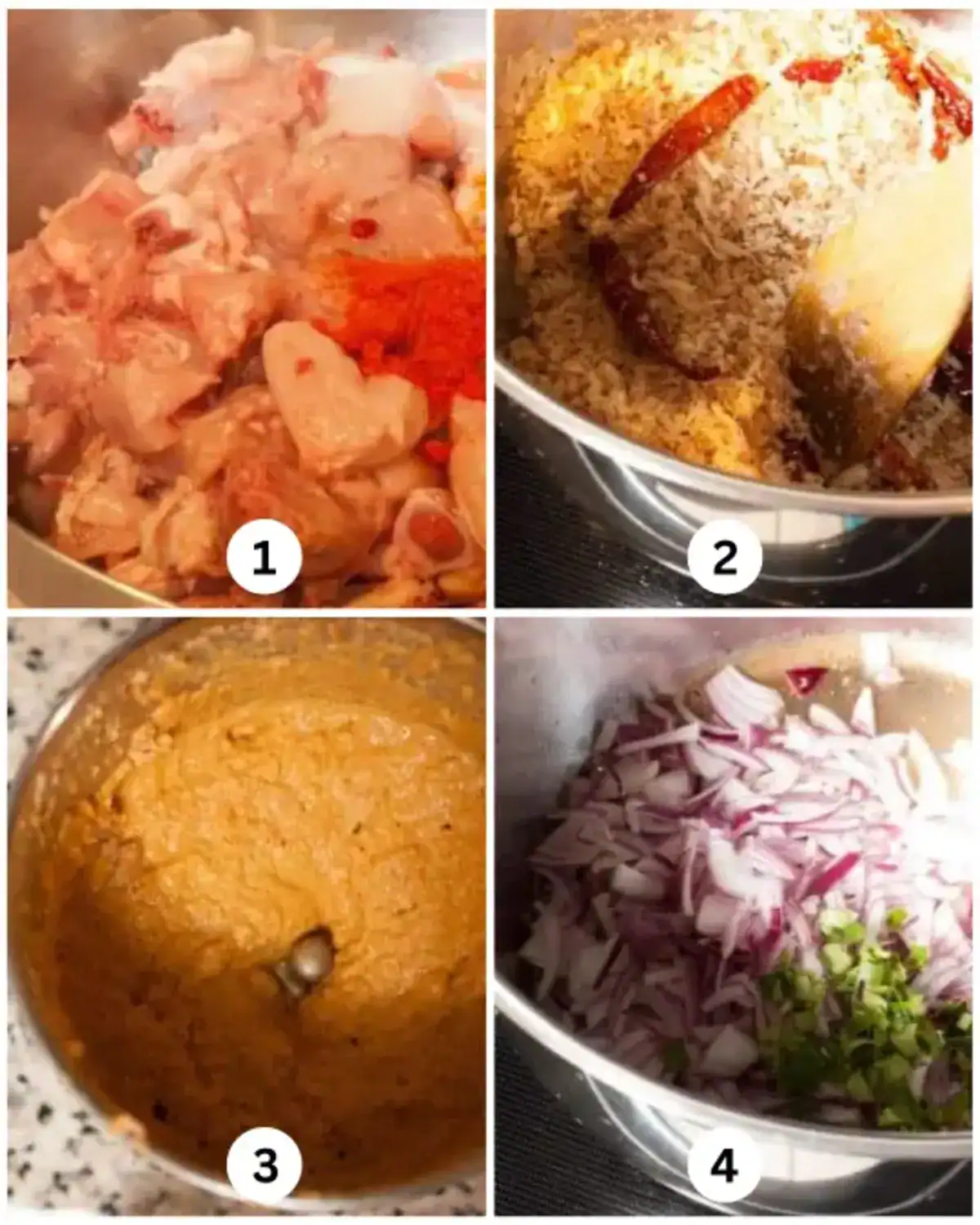
- Add ginger and garlic crushed or paste. Sauté them well. Add extra oil as needed.
- Add turmeric powder, chilli powder, coriander powder, garam masala and sauté well. Add oil as needed to fry the masalas.
- Add diced tomatoes. Mix it well. Cover and cook for 5 minutes.
- Once tomatoes are cooked, add marinated chicken pieces.
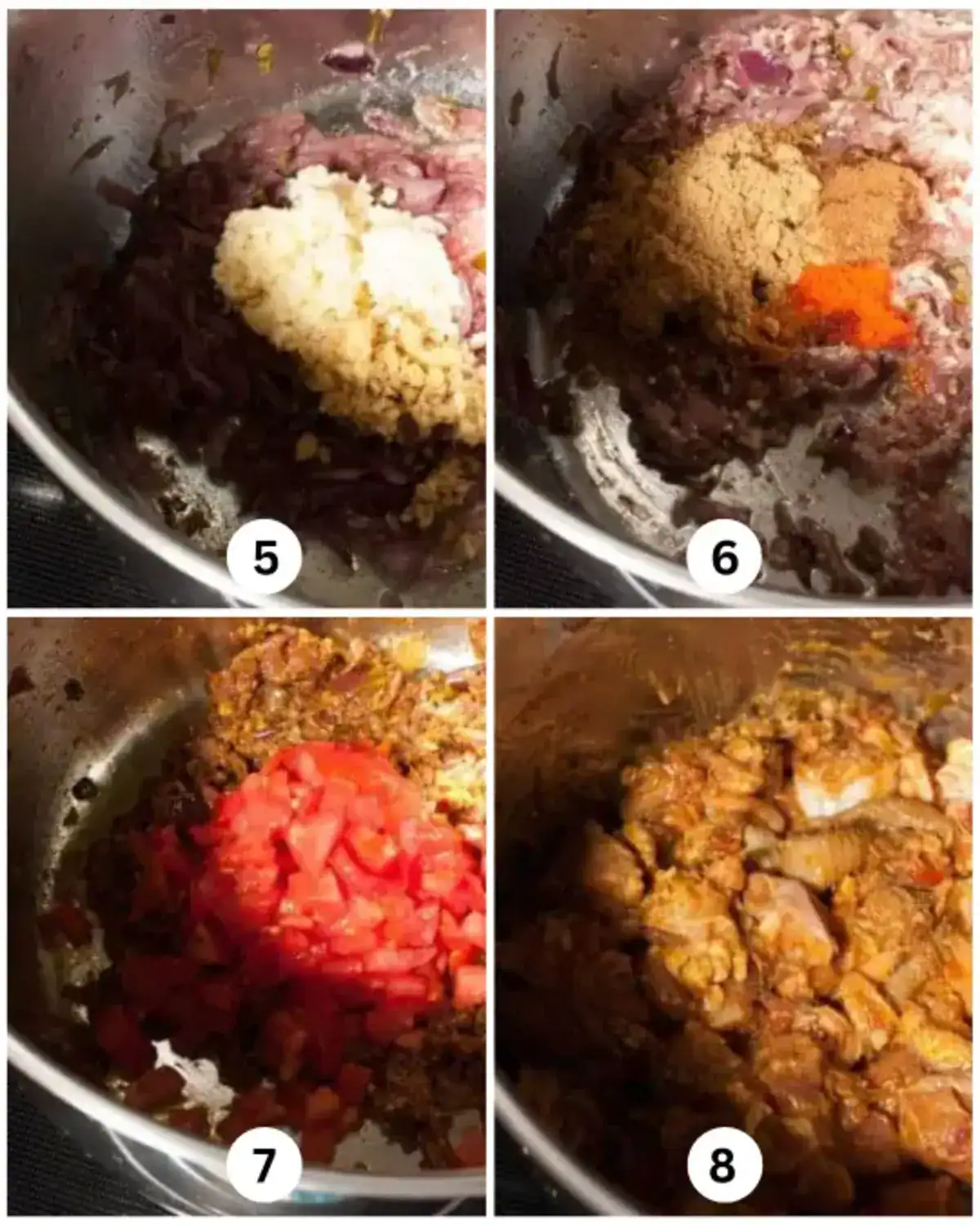
- Stir till the pieces are well coated with the masala. Cover and cook until chicken is done. It will take around 20 minutes
- Add the coconut paste, 1 cup water, and cook for another 2-3 minutes or until it boils. Adjust the salt in the gravy. Boil till the gravy is up to the desired consistency.
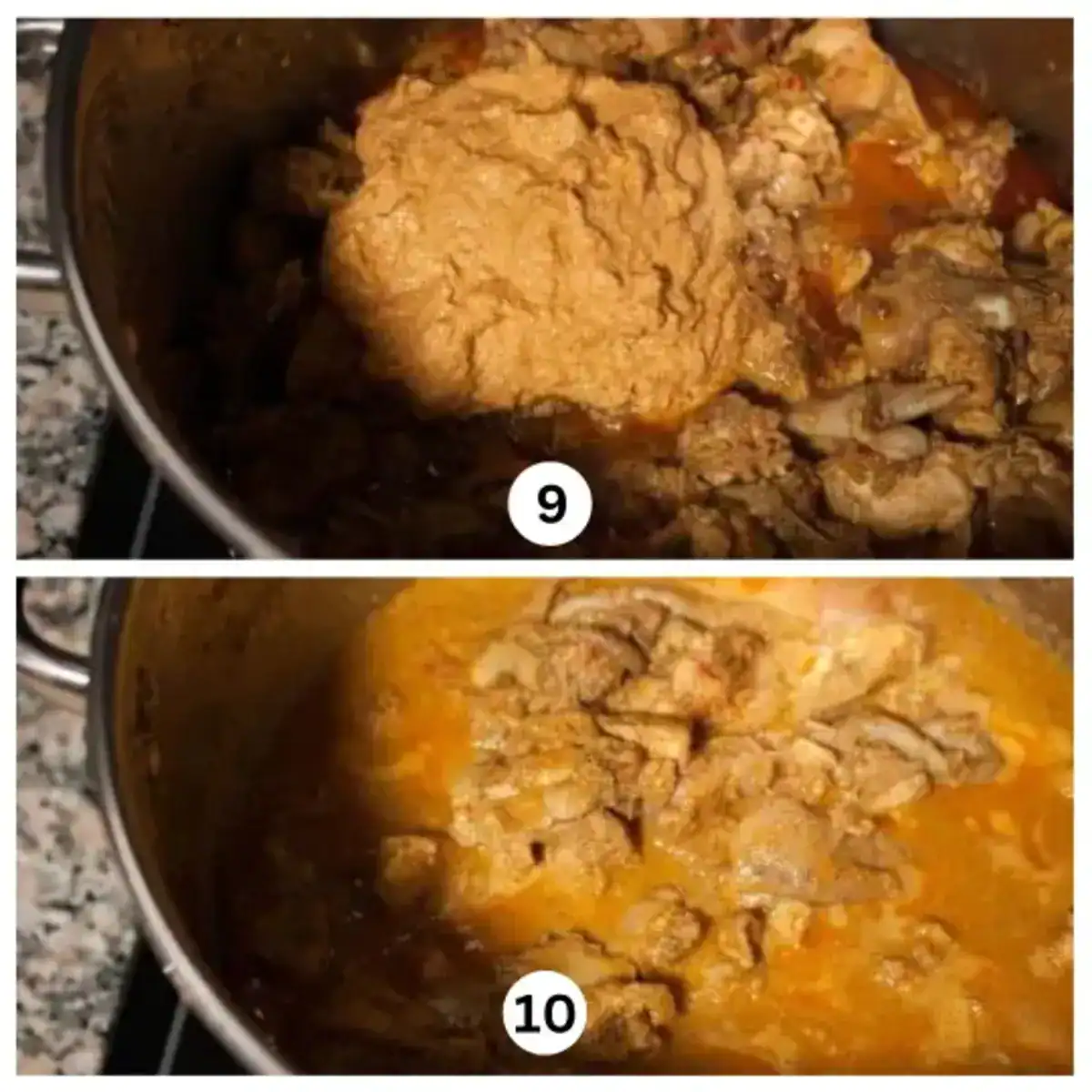
If you enjoy Kerala-style chicken curries, try our Kerala Chicken Stew Recipe next. It also uses coconut but has a completely different technique, taste, colour, and texture.
Tips And Tricks
- Roast Coconut Slowly
Use a low to medium flame. Stir continuously while roasting. This helps avoid burning. The deep, nutty flavour comes only from a slow and even roast. Do not rush this step. - Grind to a Smooth Paste
Scrape the sides of the grinder often. This makes sure everything blends properly. Add water little by little. The paste should be thick and smooth. - Use Hot Water for the Gravy
Always use hot water to adjust the curry. It keeps the temperature steady. This also helps the gravy stay smooth without splitting.
Serving Suggestions
Kerala Style Chicken Curry with roasted coconut goes best with pathiri (thin rice roti) or orotti (thicker roasted rice roti). It also pairs well with chapati or porotta. Soaking them in the gravy gives a softer texture and a richer taste.
You can also serve it with appam, idiyappam (string hoppers), or puttu (steamed rice flour cakes). These absorb the curry well and balance the heat.
With rice, it works beautifully with Kerala matta rice, basmati rice, or ghee rice. For a full Kerala-style meal, serve with matta rice, a simple beans or cabbage thoran, pappadam, and chicken fry on the side.
Storage Instructions
Varutharacha Chicken Curry tastes even better the next day. The gravy thickens and the flavour deepens. Reheat gently before serving.
Store in a clean, airtight container in the fridge. It stays fresh for 2 to 3 days.
You can also freeze the curry. It stays good in the freezer for 2 weeks. Thaw fully and reheat on the stove for best results.
Frequently Asked Questions (FAQ)
The oil comes from both the cooking oil and the natural oil released from the coconut while roasting. If it feels too much, let the curry rest and skim off the extra oil with a spoon.
The curry turns bitter if the coconut or spice powders are burnt while roasting. Always roast slowly and keep the flame low.
More Kerala Chicken Recipes To Try
I’d love to hear your thoughts if you have tried this! Please leave a ⭐️ rating and a comment below. Don’t forget to share your photos on Instagram and tag @a_little_bit_of_spice.
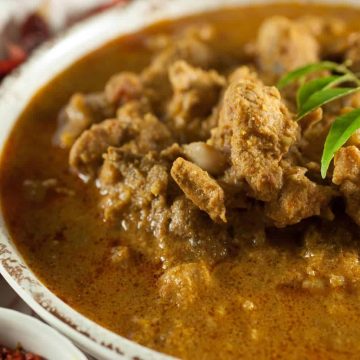
Kerala Chicken Curry with Roasted Coconut (Varutharacha Chicken Curry)
Ingredients
- 1 kilogram chicken
Marination
- 1 teaspoon salt
- ¾ teaspoon turmeric powder
- ½ teaspoon chilli powder
- 1 tablespoon lemon juice
Roasted Coconut Mix
- 1 cup grated coconut
- ¼ cup Shallots / Small onion
- 1 ½ teaspoon fennel seeds
- 8 number red chilli
Masala Gravy
- 2 number onion (medium size)
- 1 tablespoon garlic (crushed)
- 1 tablespoon ginger (crushed)
- ½ teaspoon turmeric powder
- 1 ½ tablespoon coriander powder
- 1 teaspoon chilli powder
- 1 teaspoon garam masala
- 1 number tomato (large)
- 3 sprig curry leaves
Instructions
- Marinate the cleaned chicken pieces with the ingredients listed under marination. Keep it aside for 30 minutes.
- Heat 2 teaspoon oil in a pan. Add sliced shallots. Saute well until soft and then add grated coconut, red chili, and fennel seeds. Saute well until coconut turns golden brown. Switch off the stove. Transfer the roasted coconut mix into the blender or mixi bowl. Let it cool. Then add water, grind well and make a fine smooth paste.
- Slice onion into very small pieces so that it would be easy for it to get mashed into the gravy while chicken gets cooked. Dice tomatoes into small pieces.
- Heat oil in a pan. Add sliced onion, curry leaves and salt. Adding salt helps the onion to get cooked fast. Saute them until onion is soft and turns light brown.
- Add ginger and garlic crushed or paste. Saute them well. Add extra oil as needed.
- Add turmeric powder, chilli powder, coriander powder, garam masala and saute well. Add oil as needed to fry the masalas.
- Add diced tomatoes. Mix it well. Cover and cook for 5 minutes.
- Once tomatoes are cooked, add marinated chicken pieces.
- Stir till the pieces are well coated with the masala. Cover and cook until chicken is done. It will take around 20 minutes.
- Add the coconut paste, 1 cup water and cook for another 2-3 minutes or until it boils. Adjust salt in the gravy. Boil till the gravy is up to the consistency desired.
Notes
- Roast Coconut Slowly
Use a low to medium flame. Stir continuously while roasting. This helps avoid burning. The deep, nutty flavour comes only from a slow and even roast. Do not rush this step. - Grind to a Smooth Paste
Scrape the sides of the grinder often. This makes sure everything blends properly. Add water little by little. The paste should be thick and smooth. - Use Hot Water for the Gravy
Always use hot water to adjust the curry. It keeps the temperature steady. This also helps the gravy stay smooth without splitting.
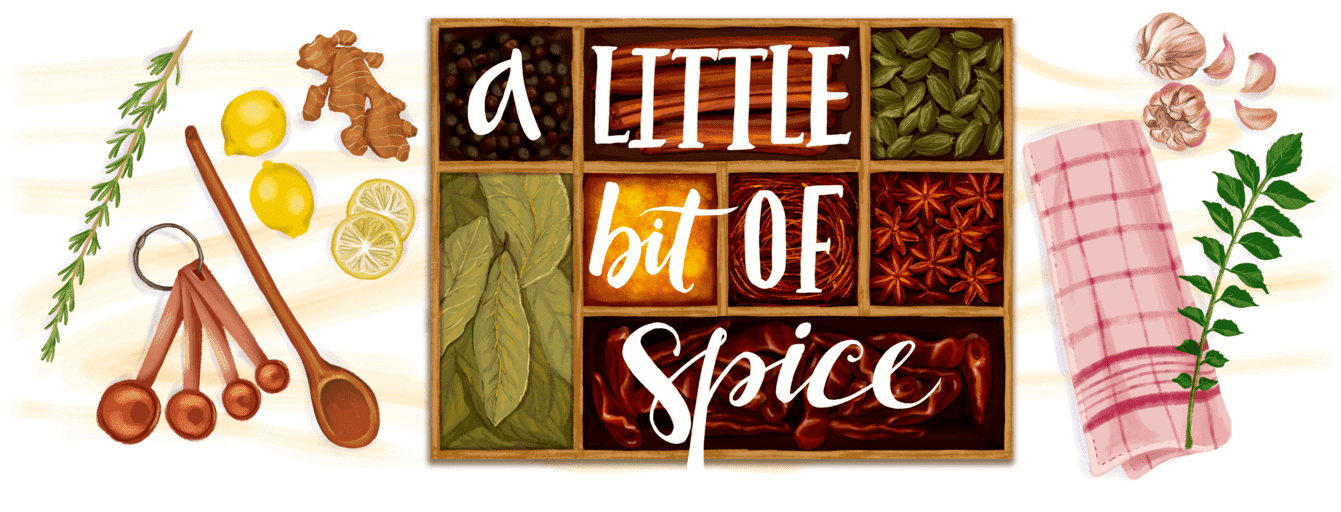

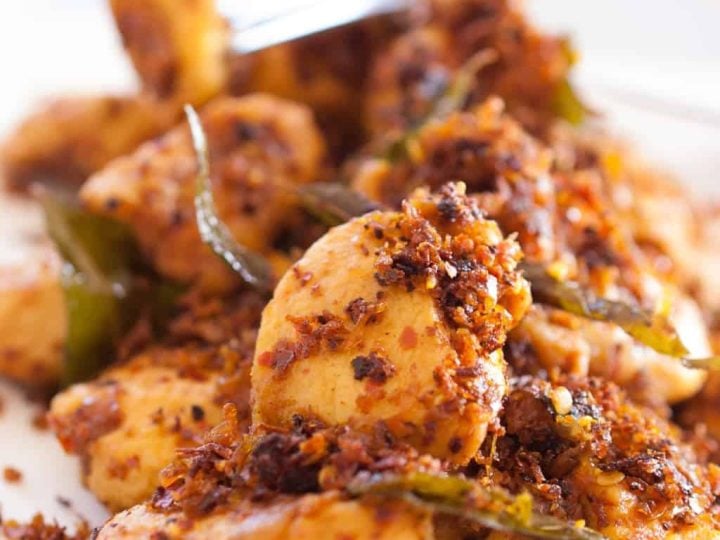
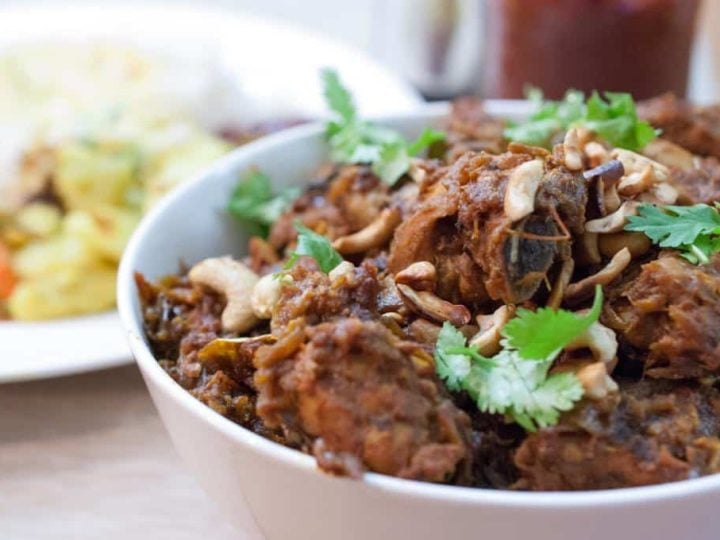
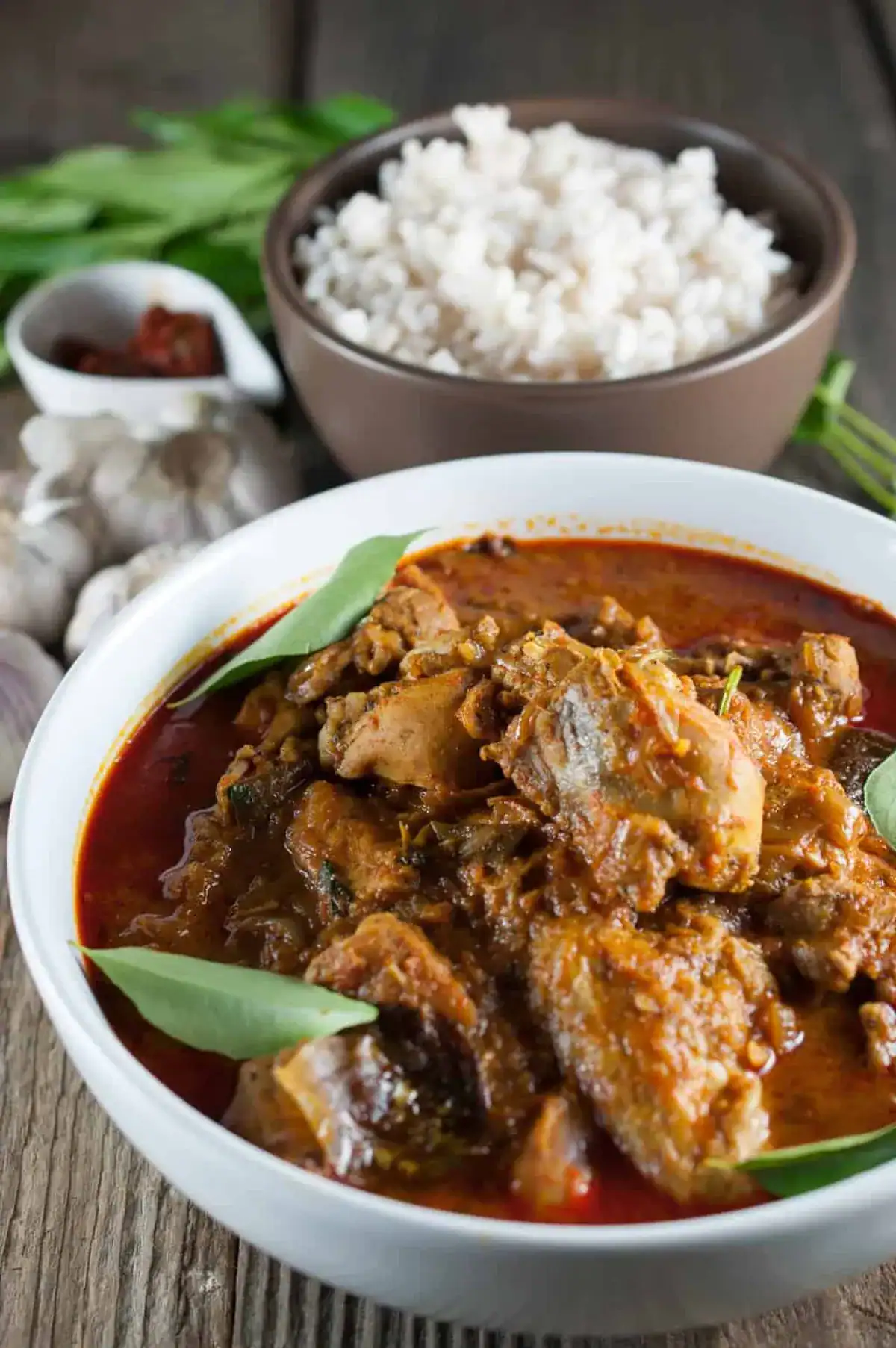
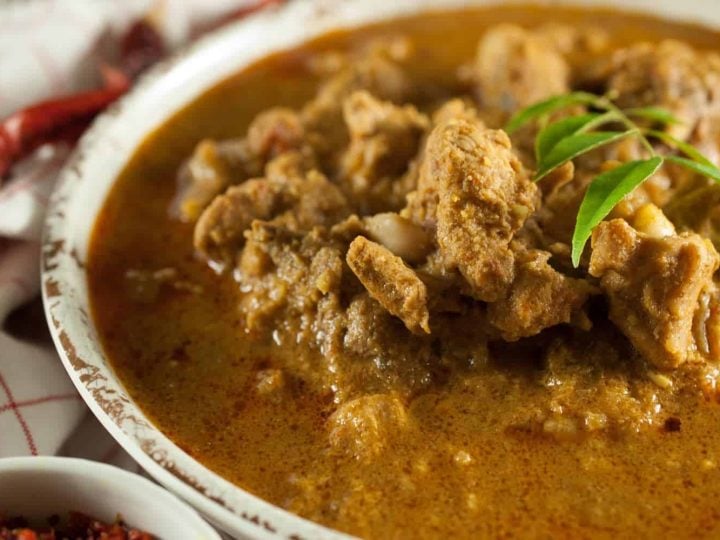
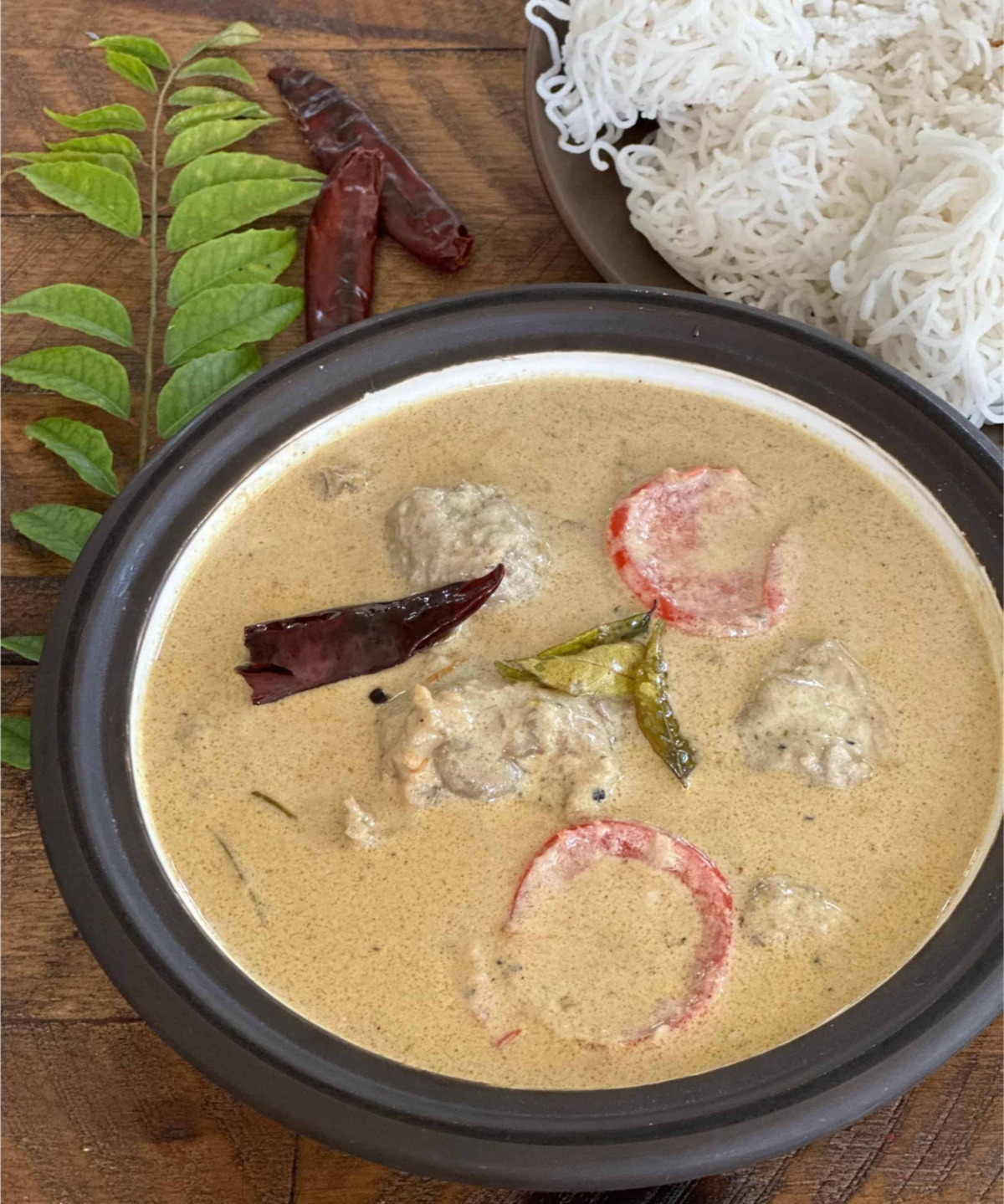
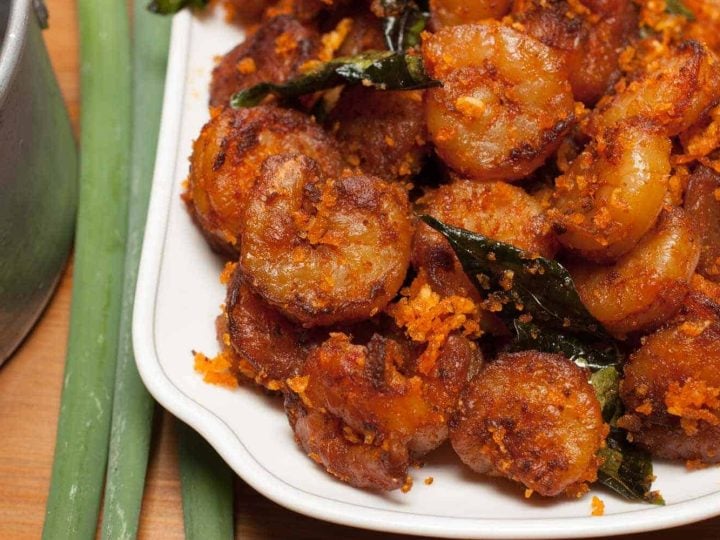
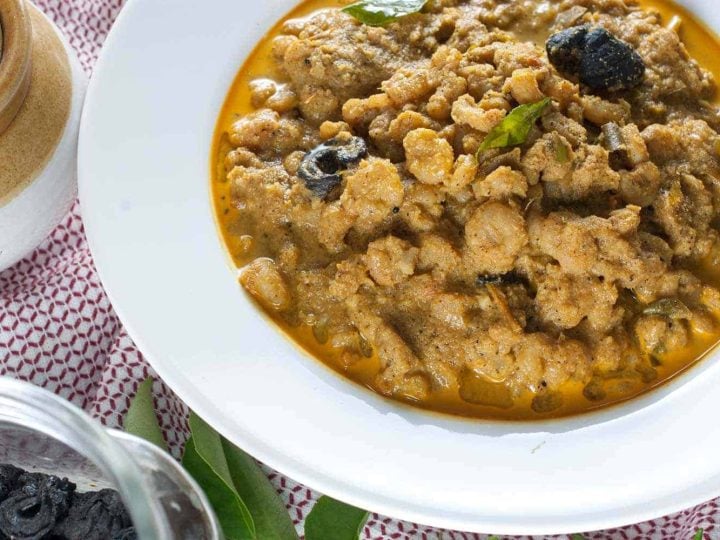
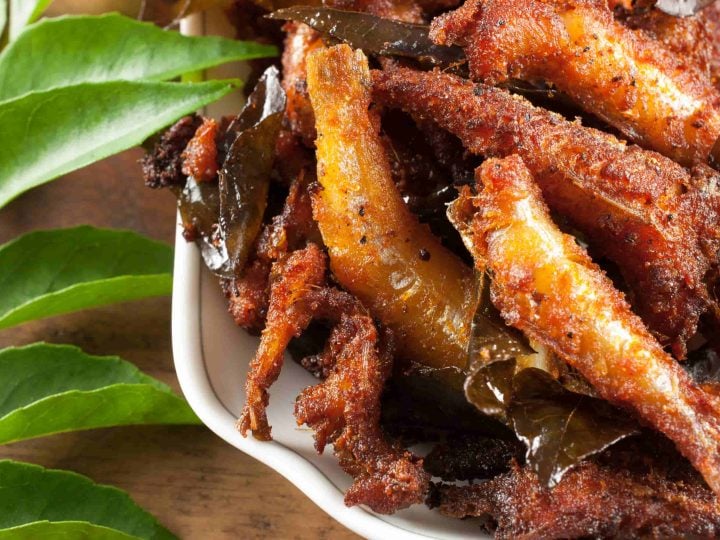
Thanks to you, my nieces and nephews think I am the best Chef ever…